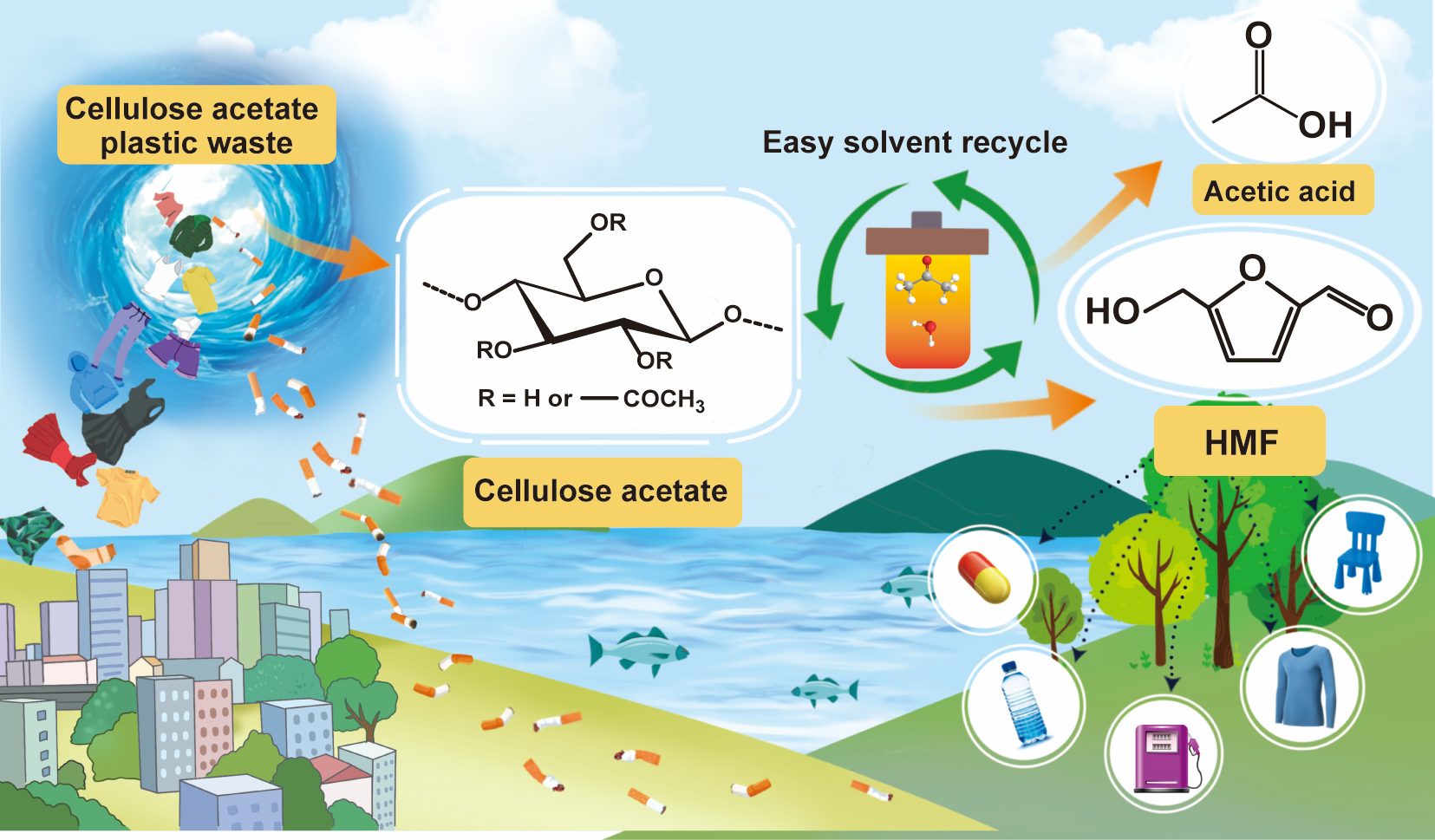废弃塑料转化One-step valorization of cellulose acetate plastic waste into 5-hydroxymethylfurfural
星期五, 29 8 月, 2025One-step valorization of cellulose acetate plastic waste into 5-hydroxymethylfurfural
Recently, Dr. Chunxiao Gong (Associate Professor), together with Prof. Shuai Li (Fujian Agriculture and Forestry University) and Dr Qixuan Lin (South China University of Technology) proposed a one-step method to convert cellulose acetate (CA) plastic waste into the high-value chemical 5-hydroxymethylfurfural (HMF). The research, titled “One-step valorization of cellulose acetate plastic waste into 5-hydroxymethylfurfural”, was published in Applied Catalysis B: Environment and Energy (IF:21.1). Dr. Chunxiao Gong is the first author, while Profs. Zhen Fang, Shuai Li and Dr Qixuan Lin are the corresponding authors.
Cellulose acetate (CA) is a widely used cellulose derivative, commonly applied in cigarette filters, textiles, and plastics. The extensive use of CA-based products generates large amounts of plastic waste. Due to its low biodegradability, CA has become a “hidden source of pollution,” persisting in the environment for more than 10 years, with degradation rates decreasing sharply as the degree of acetylation increases. This poses severe environmental challenges.
In this study, using AlCl3 as the sole catalyst in an acetone–water solvent system at 160 °C for 50 minutes, CA was converted into HMF with a yield of 53.7%, which is three times that of untreated cellulose. When real waste materials (cigarette filters and CA fabrics) were used as feedstocks, the HMF yield also exceeded 50%. This technique provides a feasible route for the upcycling of CA plastic waste.
The in-situ generated acetic acid synergistically interacted with AlCl3, where acetic acid coordinated with Al(III) to regulate Lewis acidity, suppressing side reactions and promoting the fructose dehydration pathway. Meanwhile, the acetyl groups in the CA structure enhanced interactions with acetone solvent, further improving reaction selectivity. The process was equally effective for real CA waste (e.g., cigarette filters, fabrics), demonstrating strong application potential. Compared to previous studies on cellulose conversion to HMF, this system achieved high efficiency under milder conditions and with lower catalyst loading, offering a new pathway for the valorization of CA plastic waste.
Molecular dynamics simulations revealed that CA’s acetyl groups form noncovalent interactions with acetone molecules. Acetone preferentially surrounds the C1 and C4 positions of CA, preventing unnecessary protonation at these sites and thereby reducing byproduct formation (e.g., humins). The interaction energy (ΔE) between a CA monomer and acetone reached 15.04 kcal/mol, while that between a cellulose disaccharide monomer and acetone was only 7.76 kcal/mol, showing a significant difference. During the reaction, acetic acid released from deacetylation further participated in catalysis, working synergistically with AlCl3 to promote HMF formation.
Results published in Applied Catalysis B: Environment and Energy:
C Gong, Z Ju, Q Lin, X Lv, RL Smith Jr, L Xu, Y Cao, L Shuai, Zhen Fang, Z, One-step valorization of cellulose acetate plastic waste into 5-hydroxymethylfurfural, Applied Catalysis B: Environment and Energy, 2026, 381, 125880. https://doi.org/10.1016/j.apcatb.2025.125880
———————————————————————————————————————–
醋酸纤维素塑料废弃物一步法转化为5-羟甲基糠醛
近期,团队成员龚春晓副教授联合福建农林大学帅李教授、华南理工大学博士林琦璇提出一步法将CA塑料废物转化为高价值化学品5-羟甲基糠醛(HMF)。研究以“One-step valorization of cellulose acetate plastic waste into 5-hydroxymethylfurfural”为题发表于Applied Catalysis B: Environment and Energy (IF:21.1)。龚春晓副教授为第一作者,方真教授、福建农林大学帅李教授、华南理工大学博士林琦璇为通讯作者。

Production of HMF from CA plastic waste醋酸纤维素塑料废弃物一步法转化为5-羟甲基糠醛
醋酸纤维素(CA)是一种用途广泛的纤维素衍生物,广泛应用于香烟滤嘴、纺织品和塑料等消费品。醋酸纤维素类产品的广泛使用产生了大量塑料废弃物,CA的低生物降解性使其成为一种“隐性污染源”,可在环境中可能存留超过10年,且降解速度随着乙酰化程度的升高而大幅下降,带来严峻的环境挑战。
本研究使用AlCl3作为单一催化剂,在丙酮-水溶剂系统中160°C、50分钟条件下,CA转化为HMF产率达53.7%,是未处理纤维素的3倍;当以真实废弃物(香烟滤嘴、CA织物)作为原料时,HMF产率均超过50%。这项技术为CA塑料废物的升级回收提供了可行途径。
原位生成的乙酸与AlCl3协同催化作用,乙酸通过与Al(III)形成配位络合物调节路易斯酸性,抑制副反应并促进果糖脱水路径;CA结构的乙酰基则通过增强与丙酮溶剂的相互作用进一步提高反应选择性。该工艺对真实CA废弃物(香烟滤嘴、织物等)同样有效,展现出良好的应用潜力。与前期纤维素制备HMF研究相比,该体系在更低催化剂用量、更温和条件下实现了高效制备HMF,为CA塑料废弃物的高值化利用提供了新途径。
通过分子动力学模拟发现:CA的乙酰基与丙酮分子发生更强的非共价相互作用,丙酮优先围绕在CA的C1和C4位置,阻止了这些部位发生不必要的质子化,从而减少了副产物(如腐殖质)的生成;CA单体与丙酮之间的相互作用能量(ΔE)达15.04 kcal/mol,而纤维素单体纤维二糖与丙酮仅为7.76 kcal/mol,显示出显著差异;反应过程中,乙酰基脱落生成的醋酸进一步参与催化,和AlCl3形成协同作用,促进HMF生成。
结果发表在Applied Catalysis B: Environment and Energy:
C Gong, Z Ju, Q Lin, X Lv, RL Smith Jr, L Xu, Y Cao, L Shuai, Zhen Fang, Z, One-step valorization of cellulose acetate plastic waste into 5-hydroxymethylfurfural, Applied Catalysis B: Environment and Energy, 2026, 381, 125880. https://doi.org/10.1016/j.apcatb.2025.125880